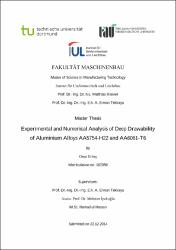| dc.contributor.advisor | İpekoğlu, Mehmet | |
| dc.contributor.advisor | Tekkaya, A. Erman | |
| dc.contributor.author | Erbaş, Onur | |
| dc.date.accessioned | 2020-03-02T12:11:52Z | |
| dc.date.available | 2020-03-02T12:11:52Z | |
| dc.date.issued | 2014 | |
| dc.identifier.citation | Erbaş, Onur (2014). Experimental and numerical analysis of deep drawability of aluminium alloys AA5754-H22 and AA6061-T6. Türk-Alman Üniversitesi, Fen Bilimleri Enstitüsü, İstanbul. | en_US |
| dc.identifier.uri | https://hdl.handle.net/20.500.12846/26 | |
| dc.description.abstract | In the recent years sheet metal forming technologies are challenged by the higher fuel economy and concerns about global warming in the automotive industry. Deep drawing is one of the most commonly used sheet metal forming process in automotive industry. Lighter and safer materials are used for automotive production to reduce the weight of vehicles. Aluminium alloys, due to their low density compared to steels, are an important group of materials, in particular for light weight construction of transport vehicles. The primary purpose of this master thesis is to determine deep drawability of two different aluminium alloys. It discusses the right material to deep draw an emergency valve cup on the bus side panel. Therefore, suitable process parameters and possible cup position according to the edge of the sheet panel are chosen for required quality of the product. In order to estimate the formability of two different aluminium alloys, they are firstly characterized with tensile and Nakajima test. Then deep drawing experiment with different process parameters is carried out to produce emergency valve cup. The experimental investigation is followed by a numerical analysis which investigates deep drawing process through simulation software. | en_US |
| dc.description.abstract | Son yıllarda saç metal şekillendirme teknolojileri, otomotiv endüstrisindeki yüksek yakıt ekonomisi ve küresel ısınma endişesi nedeniyle değişime zorlanmaktadır. Derin çekme saç metal şekillendirme yöntemleri arasında otomotiv endüstrisinde en çok kullanılan yöntemlerden biridir. Daha hafif ve güvenli malzemeler araçların ağırlıklarını azaltmak için kullanılmaya başlanmıştır. Alüminyum alaşımları, çeliğe oranla düşük yoğunluğa sahip oldukları için hafif konstrüksiyona sahip araçlarda kullanılan önemli bir malzeme grubudur. Tezin esas amacı; iki farklı alüminyum alaşımın derin çekme kabiliyetlerinin karşılaştırılmaktır. Tez acil çıkış valfi yuvasının otobüsün yan panelinde derin çekilmesi için gereken doğru malzemeyi tartışıyor. Böylece uygun proses parametreleri ve panelin kenara göre olan mümkün olan yuva pozisyonu gerekli kalitede parça üretilmek için seçilmiştir. Malzemelerin şekillendirilebilme kabiliyetlerini tahmin edebilmek için çekme ve Nakajima testleri yapılmıştır. Sonra derin çekme deneyi farklı proses parametreleri ile gerçekleştirilmiştir. Deneysel çalışmadan sonra sayısal analiz yöntemi olan simulasyon programı ile derin çekme işlemi incelenmiştir. | en_US |
| dc.language.iso | eng | en_US |
| dc.publisher | Türk-Alman Üniversitesi | en_US |
| dc.rights | info:eu-repo/semantics/openAccess | en_US |
| dc.subject | Deep drawing | en_US |
| dc.subject | Deep drawability | en_US |
| dc.subject | Thickness distribution | en_US |
| dc.subject | Derin çizim | en_US |
| dc.subject | Derin çekilebilirlik | en_US |
| dc.subject | Kalınlık dağılımı | en_US |
| dc.title | Experimental and numerical analysis of deep drawability of aluminium alloys AA5754-H22 and AA6061-T6 | en_US |
| dc.type | masterThesis | en_US |
| dc.relation.publicationcategory | Tez | |
| dc.contributor.department | TAÜ, Fen Bilimleri Enstitüsü, İmalat Teknolojisi Ana Bilim Dalı | en_US |
| dc.contributor.institutionauthor | Erbaş, Onur | en_US |

















